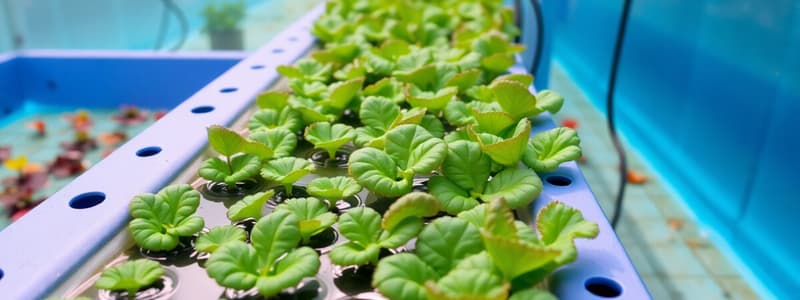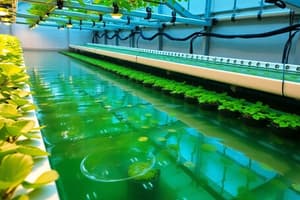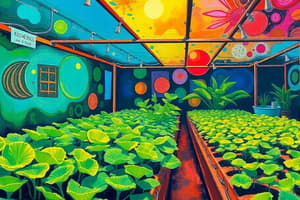Podcast
Questions and Answers
What is a mandatory requirement for the sustainability of an aquaponics system?
What is a mandatory requirement for the sustainability of an aquaponics system?
- Partnerships only
- Ongoing revenue from sales (correct)
- Government grants
- Community donations
Aquaponics systems can operate without any ongoing revenue from fish and produce sales.
Aquaponics systems can operate without any ongoing revenue from fish and produce sales.
False (B)
What are the first steps needed before establishing an aquaponics project?
What are the first steps needed before establishing an aquaponics project?
Market study and analysis, needs analysis, opportunities for phased growth, preliminary business plan model.
Before starting the aquaponics project, checking _____ is important to ensure compliance with local laws.
Before starting the aquaponics project, checking _____ is important to ensure compliance with local laws.
Which of the following is NOT a partner typically required for an aquaponics installation?
Which of the following is NOT a partner typically required for an aquaponics installation?
Match the following components with their related concepts in an aquaponics system:
Match the following components with their related concepts in an aquaponics system:
A commercial aquaponics system is a simple turn-key operation that requires no planning.
A commercial aquaponics system is a simple turn-key operation that requires no planning.
What types of utilities are essential for an aquaponics installation?
What types of utilities are essential for an aquaponics installation?
What is the main obstacle to implementing the PFAS Units in urban areas?
What is the main obstacle to implementing the PFAS Units in urban areas?
PFAS Units require specific soil conditions to function effectively.
PFAS Units require specific soil conditions to function effectively.
What type of fish is primarily raised in the Portable Farms® Aquaponics Systems?
What type of fish is primarily raised in the Portable Farms® Aquaponics Systems?
Operating costs for the PFAS Units average between $_____ and $_____ per year.
Operating costs for the PFAS Units average between $_____ and $_____ per year.
Which of the following is a benefit of using PFAS Units over traditional farming methods?
Which of the following is a benefit of using PFAS Units over traditional farming methods?
Which group is considered less price sensitive when buying produce?
Which group is considered less price sensitive when buying produce?
Match the following aspects of PFAS Units with their benefits:
Match the following aspects of PFAS Units with their benefits:
The PFAS Units can be placed on any type of land regardless of its quality.
The PFAS Units can be placed on any type of land regardless of its quality.
Locally grown, pesticide-free food can be sold at higher prices than imported produce.
Locally grown, pesticide-free food can be sold at higher prices than imported produce.
What kind of reports can be used for market analysis in aquaponics?
What kind of reports can be used for market analysis in aquaponics?
What is the estimated revenue range from fish production per 1,000m2 of PFAS Units?
What is the estimated revenue range from fish production per 1,000m2 of PFAS Units?
High-quality produce can be utilized effectively in __________ facilities that serve large volumes of consumers daily.
High-quality produce can be utilized effectively in __________ facilities that serve large volumes of consumers daily.
Match the produce type with its market characteristics:
Match the produce type with its market characteristics:
What is an important factor to consider when determining the price of produce?
What is an important factor to consider when determining the price of produce?
Aquaponics systems can only provide fresh produce during specific seasons.
Aquaponics systems can only provide fresh produce during specific seasons.
Name at least two types of clients you could sell produce to in a commercial aquaponics system.
Name at least two types of clients you could sell produce to in a commercial aquaponics system.
Flashcards
Market study and analysis
Market study and analysis
The process of assessing the demand for your aquaponics product in a specific market, including identifying target customers, competitors, and pricing strategies.
Needs analysis
Needs analysis
Determining the current supply of products similar to your aquaponics offering, identifying potential gaps in the market, and understanding the needs of your target customers.
Opportunities for phased growth
Opportunities for phased growth
Planning for gradual expansion of your aquaponics operation, starting small and scaling up as you gain experience and meet market demand.
Preliminary business plan
Preliminary business plan
Signup and view all the flashcards
State and local requirements
State and local requirements
Signup and view all the flashcards
Utilities
Utilities
Signup and view all the flashcards
Property investigation
Property investigation
Signup and view all the flashcards
Engineering assistance
Engineering assistance
Signup and view all the flashcards
Aquaponics
Aquaponics
Signup and view all the flashcards
Tilapia
Tilapia
Signup and view all the flashcards
Lack of land availability
Lack of land availability
Signup and view all the flashcards
Capital Investment
Capital Investment
Signup and view all the flashcards
Return on Investment (ROI)
Return on Investment (ROI)
Signup and view all the flashcards
Inflationary Resistance
Inflationary Resistance
Signup and view all the flashcards
Local Food Production
Local Food Production
Signup and view all the flashcards
Increased Production Efficiency
Increased Production Efficiency
Signup and view all the flashcards
Market Analysis in Aquaponics
Market Analysis in Aquaponics
Signup and view all the flashcards
High-End Consumers
High-End Consumers
Signup and view all the flashcards
Lower-End Consumers
Lower-End Consumers
Signup and view all the flashcards
Value Proposition of Locally Grown Produce
Value Proposition of Locally Grown Produce
Signup and view all the flashcards
Multi-Market Aquaponics Strategy
Multi-Market Aquaponics Strategy
Signup and view all the flashcards
Out-of-Season Produce
Out-of-Season Produce
Signup and view all the flashcards
Transportation Costs
Transportation Costs
Signup and view all the flashcards
Pesticide-Free Produce
Pesticide-Free Produce
Signup and view all the flashcards
Study Notes
Commercial Aquaponics Gold
- Written by Colle and Phyllis Davis
- Published in 2015, 2015 second edition, 2020 third edition
- Contains information about commercial aquaponics
- Updated September 2015 - Originally published March 2015
- ISBN: 978-0-9962055-1-1
Table of Contents
- Introduction
- Overview of aquaponics
- Overview of Portable Farms® Aquaponics Systems
- Company History and Bios
- Five Aquaponics Books Written by Colle and Phyllis Davis
- Revenue Sources
- Business Structure
- Investment Packages
- Appendix A: Portable Farms® Aquaponics Systems' Yield Results
- Mineral Rock Dust – Organic Additive for Micro and Macro Elements
- Aquaponics Basics
- Four-Step Analysis Process for Aquaponics
- Commercial Aquaponics - Conceptual Research
- Climatically Adapted Structures
- Basics for Commercial Aquaponics
- Planning For Success
- RENT a Greenhouse: ONE YEAR ROI
- Become a Millionaire on One Acre with Aquaponics
- Building a Commercial Aquaponics Installation
- Warehouse Aquaponics
- The Real Cost of INDOOR Aquaponics
- Overseeing Your Commercial Aquaponics Operation
- Licensing the Portable Farms® Aquaponics Systems Technology
- Executive Summary for Commercial Aquaponics
- BUSINESS PLAN
- Executive Summary
- Industry Analysis
- Market Overview
- Relevant Market Size
- Customer Analysis
- Target Consumers
- Customer Needs
- Competitive Analysis
- Direct Competitors
- Indirect Competitors
- Competitive Advantages
- Marketing Plan
- Operations Plan
- Key Operational Processes
- Milestones
- Management Team
- Management Team Members
- Management Team Gaps
- Board Members
- Financial Plan
- Revenue Model
- Financial Highlights
- Funding Requirements/Use of Funds
- Exit Strategy
- Appendix
Yearly Production from Portable Farms® Aquaponics Systems
- 100' x 100′ (30m x 30m) unit produces 80,000 vegetables and 23,000 pounds (10,400 kg) of fish
- A 24′ x 46′ (7.3m x 14m) unit produces 8,600 vegetables and 1,156 pounds (2,550 kg) of fish
- A 10' x 20 (3m x 6m) unit produces 1,100 vegetables and 400 pounds (180 kg) of fish
Aquaponics Basics
- Aquaponics is a combination of aquaculture (fish farming) and hydroponics (growing plants in water)
- Portable Farms® Aquaponics Systems grow fish and use their waste as fertilizer for vegetables in a closed loop system
- Tilapia is a popular fish for use in aquaponics systems
- Systems use less water, electricity and produce food faster than traditional farming methods
Commercial Aquaponics - Conceptual Research
- Owning a commercial aquaponics installation is a complex undertaking
- It requires a phased approach, and diverse skill sets
- A business plan is crucial to planning and securing funding for long term success
Studying That Suits You
Use AI to generate personalized quizzes and flashcards to suit your learning preferences.





